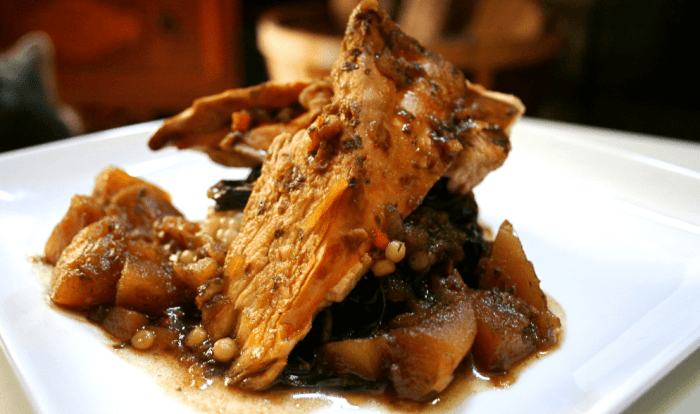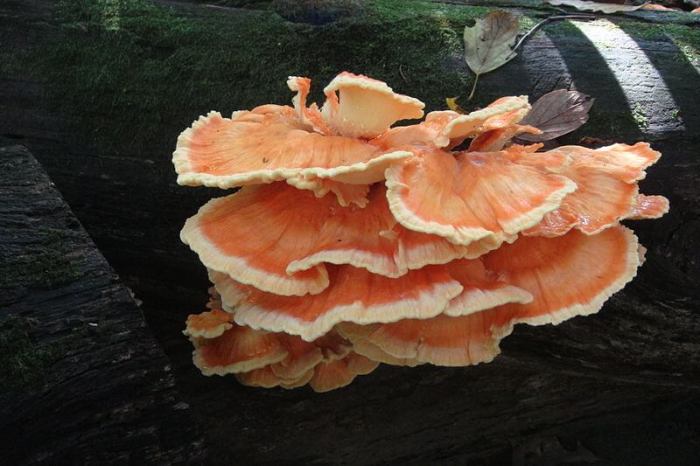
Embark on a culinary adventure with our comprehensive guide to chicken of the woods recipe. Discover the versatility, health benefits, and foraging techniques of this delectable mushroom. From soups to stir-fries, we’ve got you covered with a wide range of recipes to tantalize your taste buds.
Whether you’re a seasoned forager or a culinary novice, our in-depth exploration of chicken of the woods will inspire you to create mouthwatering dishes that showcase the unique flavors and textures of this forest delicacy.
Recipe Variations
Chicken of the woods is a versatile mushroom that can be prepared in various ways. Here are some popular chicken of the woods recipes:
From soups and stews to stir-fries and salads, chicken of the woods offers a diverse range of culinary options. Each recipe brings unique flavors and textures to the table, showcasing the versatility of this woodland delicacy.
Soups and Stews
- Creamy Chicken of the Woods Soup:A velvety and comforting soup made with sautéed chicken of the woods, blended with vegetable broth, cream, and herbs.
- Chicken of the Woods and Barley Stew:A hearty and flavorful stew featuring tender chicken of the woods, barley, root vegetables, and a rich broth.
Stir-fries
- Chicken of the Woods and Tofu Stir-fry:A savory and satisfying stir-fry with chicken of the woods, tofu, vegetables, and a flavorful sauce.
- Szechuan Chicken of the Woods:A spicy and aromatic stir-fry with chicken of the woods, vegetables, and a tangy Szechuan sauce.
Salads
- Grilled Chicken of the Woods Salad:A refreshing and flavorful salad with grilled chicken of the woods, mixed greens, vegetables, and a light dressing.
- Chicken of the Woods and Quinoa Salad:A hearty and healthy salad with chicken of the woods, quinoa, vegetables, and a zesty dressing.
Culinary Applications: Chicken Of The Woods Recipe

Chicken of the woods is a versatile culinary delight, boasting a wide range of applications. Its meaty texture and umami-rich flavor make it a sought-after ingredient in various dishes.
As a meat substitute, chicken of the woods shines in vegetarian and vegan recipes. Its firm texture mimics the bite of chicken, making it an excellent choice for stir-fries, curries, and stews. Its ability to absorb flavors allows it to blend seamlessly with other ingredients, creating flavorful and satisfying dishes.
Flavor Enhancer, Chicken of the woods recipe
Beyond its use as a meat alternative, chicken of the woods also excels as a flavor enhancer. Its intense umami flavor adds depth and richness to soups, sauces, and broths. Chefs often use it as a secret ingredient to elevate the taste of their culinary creations.
Decorative Element
In addition to its culinary merits, chicken of the woods is also prized for its aesthetic appeal. Its vibrant orange color and unique shape make it a striking garnish for salads, pizzas, and platters. Its presence adds a touch of rustic charm and visual interest to any dish.
Examples of dishes that showcase the versatility of chicken of the woods include:
- Chicken of the woods tacos with roasted corn and avocado crema
- Vegan chicken of the woods stir-fry with tofu, vegetables, and ginger-soy sauce
- Chicken of the woods soup with wild rice, mushrooms, and herbs
- Grilled chicken of the woods with chimichurri sauce
- Chicken of the woods pizza with caramelized onions, goat cheese, and arugula
Health Benefits and Nutritional Value

Chicken of the woods is a nutritious edible mushroom packed with essential vitamins, minerals, and antioxidants. Its consumption has been associated with several potential health benefits, including improved immunity, reduced inflammation, and even cancer prevention.
In terms of nutritional value, chicken of the woods is an excellent source of:
- Protein:Provides essential amino acids for tissue growth and repair.
- Fiber:Supports digestive health and promotes satiety.
- Vitamins:Rich in vitamins B1, B2, B3, and D, which play vital roles in energy metabolism, nerve function, and bone health.
- Minerals:Contains potassium, phosphorus, magnesium, and iron, essential for electrolyte balance, bone strength, and red blood cell production.
- Antioxidants:Chicken of the woods is a rich source of antioxidants, including ergothioneine, which has been linked to reduced inflammation and improved immune function.
Potential Health Benefits
Research suggests that consuming chicken of the woods may provide the following health benefits:
- Immune system enhancement:The high levels of vitamins and antioxidants in chicken of the woods support immune cell function and protect against infections.
- Reduced inflammation:Antioxidants like ergothioneine have anti-inflammatory properties, which may help alleviate chronic inflammation linked to various diseases.
- Cancer prevention:Some studies indicate that compounds in chicken of the woods may have anticancer effects, potentially inhibiting tumor growth and spread.
- Improved cardiovascular health:Chicken of the woods contains fiber, which helps lower cholesterol levels and supports heart health.
Foraging and Identification
Embarking on a foraging adventure for chicken of the woods is an exciting experience that requires keen observation and responsible practices. Let’s delve into the world of identifying and sustainably harvesting this delectable mushroom.
Seasonal Availability and Habitat
Chicken of the woods flourishes during the late summer and fall months, typically from August to November. Its preferred habitat includes moist, deciduous forests, where it can be found growing on fallen logs or stumps of oak, maple, beech, and other hardwood trees.
Identifying Chicken of the Woods
Identifying chicken of the woods is relatively straightforward, but it’s crucial to exercise caution and avoid consuming any mushrooms that you’re not absolutely certain about. Here are some key characteristics to look for:
- Shape and Size:Chicken of the woods forms shelf-like clusters that can range from small to large, with some specimens reaching up to 12 inches in diameter.
- Color:The upper surface of the mushroom is typically bright orange or yellow, while the underside is white or cream-colored.
- Texture:The flesh of chicken of the woods is firm and slightly spongy, with a texture reminiscent of chicken meat.
- Spores:The spores of chicken of the woods are white or cream-colored and can be seen on the underside of the mushroom.
Responsible Foraging Practices
When foraging for chicken of the woods, it’s essential to practice responsible harvesting techniques to ensure the preservation of the mushroom’s natural environment. Here are some guidelines to follow:
- Identify Clearly:Be absolutely certain that you have correctly identified the mushroom as chicken of the woods before consuming it.
- Harvest Sustainably:Only harvest a portion of the mushroom, leaving the base intact to allow it to continue growing.
- Respect the Environment:Avoid disturbing the surrounding area and leave the forest as you found it.
Culinary Inspirations and Pairing Suggestions

Chicken of the woods is a versatile culinary ingredient that can be incorporated into various dishes to enhance their flavor and nutritional value. Its meaty texture and mild, earthy taste make it an excellent substitute for chicken in many recipes.
This edible mushroom pairs well with a wide range of ingredients, including vegetables, herbs, spices, and sauces. Its versatility allows for endless culinary creations, inspiring chefs and home cooks alike to experiment with innovative dishes.
Complementary Ingredients and Flavors
To complement the earthy flavor of chicken of the woods, consider incorporating ingredients that add sweetness, acidity, or a touch of spice. Some suggested pairings include:
- Vegetables:Onions, garlic, carrots, celery, bell peppers, mushrooms, asparagus, broccoli, spinach, kale
- Herbs:Thyme, rosemary, oregano, sage, basil, parsley, cilantro
- Spices:Salt, pepper, paprika, cumin, turmeric, ginger, garlic powder, onion powder
- Sauces:Soy sauce, teriyaki sauce, hoisin sauce, barbecue sauce, marinara sauce, cream sauce
Pairing Suggestions
Here are some suggested pairings for chicken of the woods in various dishes:
| Main Course | Side Dish | Beverage |
|---|---|---|
| Chicken of the Woods Tacos | Roasted Vegetables with Chicken of the Woods | IPA or Lager |
| Chicken of the Woods Stir-Fry | Creamy Polenta with Chicken of the Woods | Pinot Noir or Chardonnay |
| Chicken of the Woods Pizza | Mashed Potatoes with Chicken of the Woods Gravy | Cider or Mead |
| Chicken of the Woods Soup | Sautéed Greens with Chicken of the Woods | Herbal Tea or Kombucha |
End of Discussion

As you delve into the world of chicken of the woods, you’ll discover a treasure trove of culinary possibilities. From its nutritional value to its versatility as a meat substitute, this mushroom offers endless opportunities for culinary exploration. So gather your ingredients, sharpen your knives, and prepare to embark on a gastronomic journey that will leave you craving more.
FAQ Summary
What are the health benefits of chicken of the woods?
Chicken of the woods is rich in vitamins, minerals, and antioxidants, making it a nutritious addition to your diet. It contains vitamin D, which is essential for bone health, and antioxidants that help protect against cell damage.
How do I identify chicken of the woods?
Chicken of the woods is characterized by its bright orange color and shelf-like shape. It typically grows on oak trees and can be found from spring to fall. Be sure to consult a field guide or experienced forager to confirm identification before consuming any wild mushrooms.





